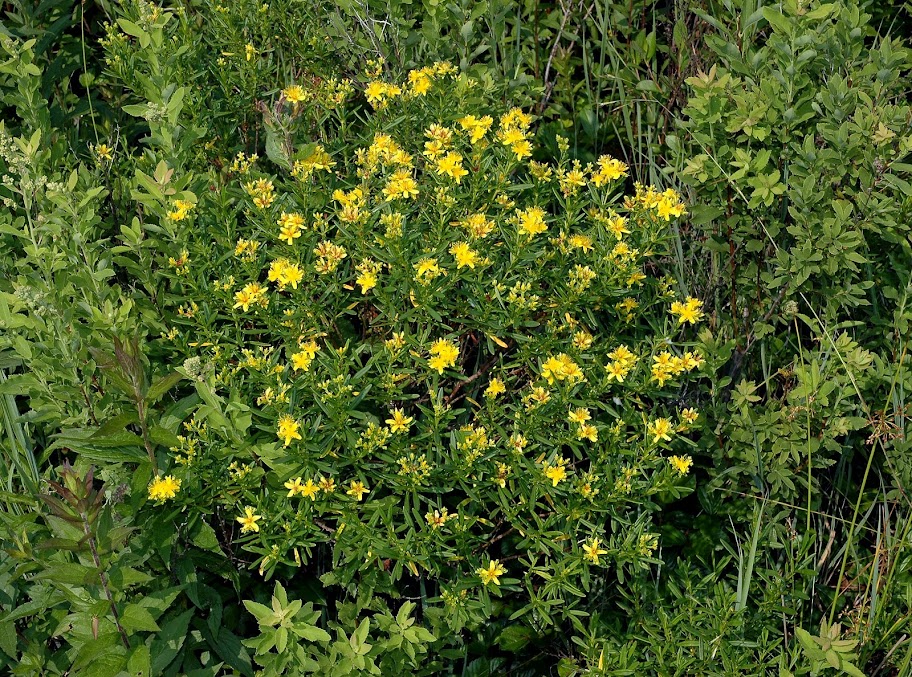With its dense foliage, yellow blooms, and adaptability, the shrubby St. John’s wort plant (Hypericum prolificum) is a fabulous addition to gardens across North America. This medium-sized woody shrub brightens borders and foundation plantings while also attracting pollinators and serving as a larval host.
Whether you’re a beginning or experienced gardener the shrubby St. John’s wort is easy to incorporate into diverse landscapes. Read on for tips on caring for this underused native treasure.
An Overview of Shrubby St. John’s Wort
Shrubby St. John’s wort typically grows 3-4 feet tall and wide in full sun to part shade conditions. It features small green leaves and produces cheerful clusters of yellow flowers from early summer to early fall. The blooms give way to interesting brown seed pods.
This North American native grows well in zones 3-8, tolerating cold winters and hot summers. It thrives in average garden soils with medium moisture but also handles clay, sand, drought, and short periods of flooding. Once established, shrubby St. John’s wort is even rabbit and deer resistant!
Beyond its hardy nature, versatility, and beauty, this shrub offers ecological benefits. It hosts several moth and butterfly caterpillars while attracting beneficial pollinators of all kinds to its flowers. Birds also eat the seeds and take shelter in the branches during winter.
How to Grow Shrubby St. John’s Wort from Seed
Shrubby St. John’s wort can be grown from seed, bare root plants, and potted nursery starts. Starting from seed is an affordable option and allows you to grow lots of new plants. Here are some tips:
-
Sow fresh seeds in fall or after cold stratifying over winter. They need light to germinate
-
Press them onto the soil surface and lightly cover with compost or vermiculite. Keep damp but not wet.
-
Germination occurs in 10-14 days at soil temperatures around 55°F.
-
Transplant seedlings when they reach 2-3 inches tall. Harden off before planting outside.
-
Grow on in pots until shrubs are about 6 inches then transplant into their permanent locations.
What to Know About Bare Root and Container Shrubby St. John’s Worts
Mail order nurseries like Prairie Moon Nursery sell shrubby St. John’s wort as bare root plants and potted starts. This provides instant gratification over growing from seed. Here’s what to expect:
-
Bare roots are dormant plants shipped in spring and fall. They establish quickly when planted during cool weather.
-
Potted plants come in 3-packs or trays of 32-50 starts. These are ready to be planted into the garden anytime the soil is workable.
-
Buying nursery plants avoids the germination wait of seeds. But availability is limited by the nursery’s inventory each year.
How to Plant and Care for Shrubby St. John’s Wort
To help your new shrubby St. John’s wort thrive:
-
Select a site with full sun to light shade and decent drainage. Amend clay or sandy soils with compost.
-
Space plants 3-4 feet apart. Follow planting instructions provided with bare root or potted purchases.
-
Water regularly until established, about 1-2 inches per week. Then water only during drought.
-
Apply mulch around the shrub to conserve moisture and reduce weeds.
-
Prune lightly in early spring to shape and thin out older stems. Avoid shearing.
-
Divide overgrown shrubs in spring or propagate new plants from stem cuttings.
Designing With Versatile Shrubby St. John’s Wort
Some ideas for showcasing shrubby St. John’s wort in your landscape:
-
Use it as an informal flowering hedge along a property line or garden border.
-
Feature one or more as specimen plants in a perennial or native plant garden.
-
Plant several together for a lush, vibrant burst of color in a bed.
-
Tuck one into a rain garden, native meadow, or wildlife habitat.
-
Include it in a landscape island, buffer strip, or erosion control area.
-
Grow one in a large pot on a patio or deck for up close admiration.
Overcoming Potential Problems
Shrubby St. John’s wort is not susceptible to many issues, but watch for:
-
Poor flowering if planted in excessive shade. It needs at least 4 hours of direct sun daily.
-
Leggy growth in too much shade or competition. Improve light and air circulation.
-
Root rot in soggy soil. Improve drainage and avoid over-watering.
-
Leaf spot during humid weather. Promote air circulation and remove affected leaves.
The Many Merits of Shrubby St. John’s Wort
With so many assets, it’s easy to see why shrubby St. John’s wort deserves a spot in more gardens. This tough, wildlife-friendly shrub brings multi-season beauty to gardens in diverse climates and conditions. Add its cheery blooms and eco-benefits to your landscape!
What’s the Next Step?
Picked out your plants? View our Resource Guide of garden centers, seed sources, landscapers, education resources, and more!
Where Should I Start?
Check out the Grow Native! Committee’s Top Ten picks of native plants for a particular purpose.
St. John’s Wort – Hypericum – Growing St Johns wort
- The Ultimate Guide to Growing Strawberries in Raised Beds - August 8, 2025
- No-Dig Garden Beds: The Easiest Way to Grow a Beautiful Garden - August 6, 2025
- How to Protect and Preserve Wood for Raised Garden Beds - August 6, 2025

